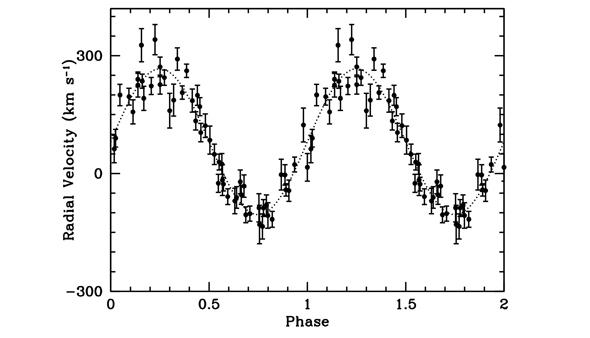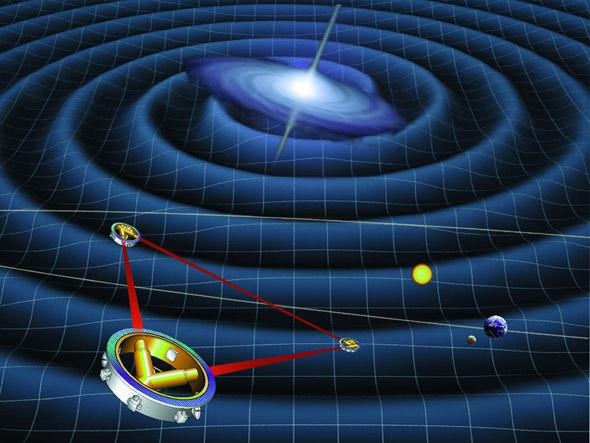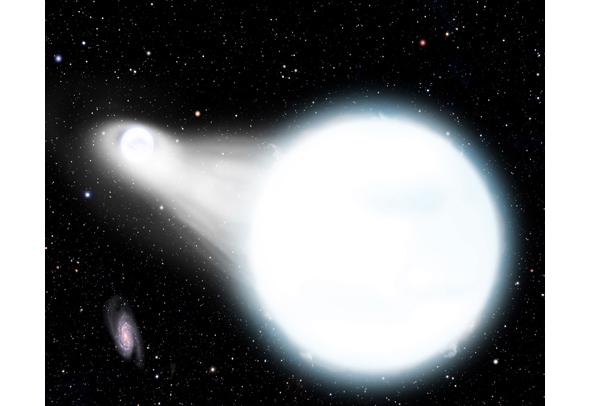Every now and again I read an astronomy paper that is written in cool, even tones but makes the hair on the back of my neck stand up.
“A New Gravitational Wave Verification Source” is one such paper.
It describes an odd star system named WD 0931+444, which had been thought to be a cool red dwarf star orbiting a white dwarf (the burnt-out cinder of a star that used to be like the Sun but has long since used up all its fuel, blew off its outer layers, and is now a hot, dense Earth-size ball).
However, not all is as it seems. For one, it now looks very much like the red dwarf is not affiliated with the white dwarf at all; it’s just coincidentally lined up with it in the sky, giving it the illusion of proximity.
For another, the white dwarf actually is in a binary system … but with another white dwarf that’s too faint to be seen directly!
So how do we know it’s there? The white dwarf we do see is hot, and glows. Astronomers observed it using a spectrograph, which breaks up its light into individual colors, allowing them to determine quite a bit about the star. What they found is that the star’s spectrum exhibits a clear cyclic Doppler shift, which is what you get when a star orbits another star. When it’s in the part of its orbit where it’s approaching us, its light is shifted to the blue, and when it recedes the light red shifts. It does this over and again, every orbit.
Analysis of the period of the shift and knowing the mass of the white dwarf (which can also be found by its spectrum, and is about one-third of the Sun’s mass) shows that the invisible companion must also be a white dwarf, with a mass of about one-seventh of the Sun.
And this is the part that freaks me out: The period of the white dwarfs, the time it takes them to orbit each other, is 20 flipping minutes.

Mapping the red and blue shift of the star’s spectrum shows a clear Doppler shift (vertical displacement in the graph, indicating velocity). As the stars orbit one another, the one emitting light moves toward and away from us, creating the shift.
Graph by Kilic et al.
20 minutes. Think about that: Two stars, both ancient and dead, are orbiting each so closely that they toss each other around in an orbit that is shorter than the length of your standard sitcom.
How close together are they? They’re separated by a mere 130,000 kilometer (83,000 miles)—that’s only about one-third the distance from the Earth to the Moon. And they orbit each other at the incredible speed of 300 km/sec—nearly 700,000 mph.
See? Neck-hair-raising time.
It gets better. They orbit so tightly that they undergo a bizarre effect predicted by Einstein: They emit gravitational waves, literally creating ripples in the very fabric of spacetime itself. Any two objects revolving around each other do this, but when they are very massive and moving very quickly, the waves are stronger. Now don’t get me wrong: “Stronger” is (har har) a relative term. It’s still an incredibly weak effect.
But it adds up. Emitting these waves steals energy from the stars, and over time their orbit shrinks. Slowly, ever so slowly, they are getting closer together. Eventually, probably in the next few million years, they will get close enough together that they’ll merge, forming one (bizarre) object. It’s not exactly clear what will happen then; the two stars aren’t quite massive enough to explode as a supernova when that happens. They may instead form a weird, more massive white dwarf with a layer of helium covering its surface that will merrily fuse away into carbon, releasing vast amounts of energy and brightening a lot.
The very, very cool thing about all this is that detecting gravitational waves is incredibly difficult because they are so weak, but WD 0931+444 is an excellent candidate for us to see them. Remember, a gravitational wave is a ripple in space, and when it passes over an object, it literally expands and contracts the object, similar to the way a cork floating in water will bob up and down when a wave passes under it. Astronomers have been trying to build detectors to see this expansion and contraction of space, and so far there hasn’t been a signal strong enough to detect.
But a possible future space mission called eLISA (the Evolved Laser Interferometry Space Antenna) could very well see them. eLISA will use three spacecraft flying in formation that use lasers to precisely determine their separation; despite being separated by millions of kilometers, their distances to each other will be known to an accuracy of—get this—one-trillionth of a meter. To give you a sense of scale, a human hair is 100 million times thicker than that!

Drawing depicting the eLISA spacecraft flying in formation far from Earth.
Drawing by NASA
When a gravitational wave passes over the spacecraft, their separation will change by a tiny amount, and that will be measurable. I’ll note that years ago, the mission was co-sponsored by NASA and I worked on the education and public outreach for it; but due to funding woes NASA pulled out. It’s now a European Space Agency mission, planned for launch around 2034.
eLISA will measure the gravitational waves from astronomical sources. Only a handful of such cosmic objects are known; WD 0931+444 brings the total to nine (hence the title of the journal paper).
What’s not to love about this story? We have an invisible star, a misleadingly aligned star, a ridiculously rapid orbital period due to the mighty force of gravity, a weird effect that has only been seen indirectly but is known to exist, a subtle and patient effect that will eventually doom those stars, and a potential space mission using incredibly advanced technology to see it.
Science! I really do love this stuff.
